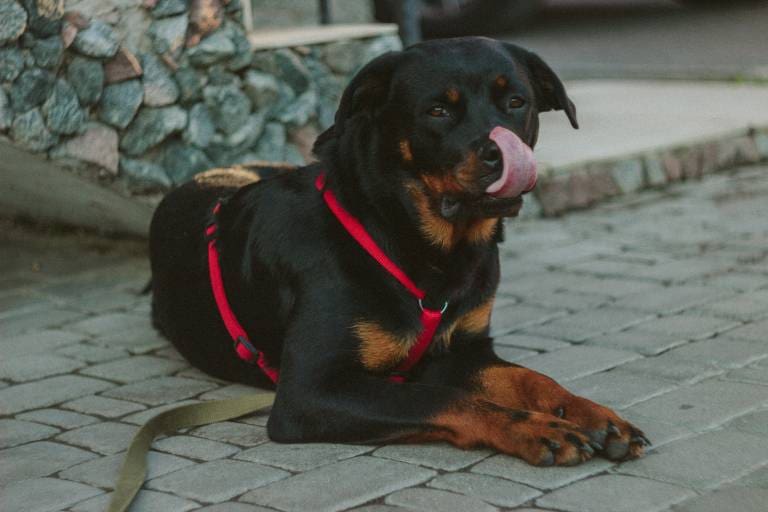How Often Do Puppies Pee?
Post Date:
December 10, 2024
(Date Last Modified: November 13, 2025)
Puppy urination patterns change rapidly as they grow, and owners often track frequency to assess house-training progress and health.
Typical pee frequency by age
Newborn puppies are largely dependent on their dam for elimination and do not control bladder function the way older pups do; voiding is often stimulated by the mother and caretakers during the first weeks of life.
Neonatal and very young puppies may urinate as often as every 15–30 minutes when stimulated by nursing and handling, especially during the first 2 weeks of life [1].
Puppies at 2–4 months of age commonly need 6–8 opportunities outside per day to avoid accidents while house-training [2].
From about 5–12 months the intervals between eliminations tend to lengthen progressively toward adult norms, with many adolescents handling 4–6 outings daily depending on size and training [2].
How size and breed affect bladder capacity
Smaller breeds usually have smaller bladder volumes and often require more frequent toilet opportunities than large breeds of the same age [3].
As a simple comparison, toy-breed puppies may need to urinate every 1–2 hours during the day when very young, while large-breed puppies may manage 2–4 hours between outings as they mature [3].
Certain breeds show behavioral tendencies that influence bladder control; for example, some terrier types can be more excitable and may have more frequent excitement-related urination, whereas some larger working breeds tend to develop delayed control as their bodies and nervous systems mature [1].
Rapid growth spurts can temporarily alter bladder capacity because body weight increases faster than neuromuscular coordination in some breeds, creating periods where a puppy seems to need more outings than before [5].
Daily patterns: daytime vs. nighttime urination
Overnight bladder holding capacity improves with age; many puppies can sleep through 4–6 hours by about 4 months, and most adult dogs can hold 8–10 hours overnight, though individual variation is common [4].
Naps and short play sessions frequently precede small-volume voids in puppies because excitement and sudden activity can trigger a reflexive urine release without prior warning [3].
Managing late-night waking is usually approached by gradually lengthening the time between pre-bed and first-morning outings by 15–30 minutes every few nights while ensuring access to water earlier in the evening is moderated [2].
Bladder development and physiological timeline
Bladder control relies on neuromuscular maturation of the detrusor muscle and sphincter mechanisms, which typically progress through the first several months of life and continue improving up to roughly 6–12 months of age [5].
Renal concentrating ability and daily urine production change as kidneys mature; normal canine urine output often ranges around 20–40 mL/kg/day in healthy adult dogs, and puppies follow a maturation curve toward that range [1].
Because bladder volume correlates roughly with body weight, a practical clinical approximation is that bladder capacity increases in proportion to growth rather than on a fixed timetable, so weight-based expectations are more reliable than age alone [5].
Feeding, water, and activity influences
Meal timing influences elimination: most puppies will urinate within 10–30 minutes after eating, so aligning outings with meals and immediate post-play rest reduces indoor accidents [2].
Free access to water during the day will increase total urine output; for example, offering an extra cup (8 fl oz / 240 mL) of water spread over a day can increase daytime trips by one or more, depending on size and activity [3].
Certain foods and medications have diuretic effects that raise frequency, including some herbal supplements and loop diuretics prescribed medically; when a puppy starts a new medication, monitor frequency and consult a veterinarian if trips increase suddenly [4].
House-training schedules and practical timing
Ages and schedules can be structured to build bladder control progressively while matching physiological needs; using predictable meal and outing times produces repeatable opportunities for elimination and reward-based learning [2].
Crate use helps prevent unsupervised accidents; a general guideline is not to leave a puppy in a crate longer than their bladder capacity allows (for many puppies this approximates hours equal to their age in months plus one, though this is a behavioral rule rather than a strict medical formula) [2].
Cue training and immediate rewarding for outdoor elimination improve reliability; reward timing within 1–3 seconds of the elimination event is most effective for associating the behavior with the cue [3].
| Age | Estimated outings/day | Typical overnight hold |
|---|---|---|
| 0–8 weeks | Multiple small eliminations stimulated frequently | Cannot hold; mother-assisted elimination |
| 2–4 months | 6–8 outings/day [2] | 4–6 hours for many pups [4] |
| 5–12 months | 4–6 outings/day as training progresses [2] | 6–8 hours for many adolescents [4] |
| Adult | 3–5 outings/day commonly | 8–10 hours typical for healthy adults [1] |
Distinguishing normal frequency from problems
Sudden increases in the number of daily voids or new accidents in a previously reliable puppy should be treated as a potential medical concern and evaluated, especially if accompanied by straining, vocalization, or changes in urine color or odor [4].
Markedly decreased frequency with large volumes passed infrequently can indicate obstruction or neurologic impairment and requires prompt veterinary attention [4].
Behavioral causes such as anxiety or submissive/excitement urination are common in young dogs and often coexist with normal physiologic needs; differentiating behavioral patterns from true polyuria or dysuria usually requires observation and sometimes diagnostic testing [3].
Common medical causes of frequent urination
Urinary tract infections are a frequent cause of increased frequency and urgency and commonly present with dysuria, licking at the vulva or prepuce, and sometimes blood in the urine; diagnosis is typically by urinalysis and urine culture [4].
Systemic diseases such as diabetes mellitus and chronic kidney disease often produce polyuria and polydipsia; in diabetes the urine frequently has a sweet smell and tests positive for glucose on dipstick, while kidney disease commonly shows isosthenuria or azotemia on laboratory tests [1].
Urinary incontinence can be congenital, hormonally related, or neurologic; signs include involuntary leakage when resting or sleeping, and assessment often includes imaging and specialized testing in addition to urinalysis [4].
Immediate management and when to seek veterinary care
At-home short-term measures include recording frequency, volume estimates, color, and any straining or discomfort, and withholding nonessential diuretic substances until evaluation if clinically safe to do so [3].
Same-day veterinary attention is recommended for puppies that are straining to urinate, producing only a few drops, vomiting, lethargic, or showing blood in the urine, as these signs can indicate obstruction or severe infection [4].
Bring a concise log of onset, frequency, associated behaviors, recent diet or medication changes, and a fresh, refrigerated urine sample if possible to facilitate timely diagnostics such as urinalysis and urine culture [2].
Additional practical details can help turn the general expectations above into a reliable routine that supports both house-training and early detection of medical issues.
For daytime scheduling, a commonly used pattern for a 2–4 month puppy is outings every 1.5–2 hours during waking hours, with an immediate outing after each meal and after 10–15 minutes of vigorous play to reduce excitement-related accidents [2].
For puppies aged 5–12 months, stretching intervals to roughly every 2–4 hours during the day is reasonable for many medium and large breeds as training progresses, with additional short outings after naps and long play sessions [2].
When planning nighttime management, many owners aim to gradually increase the first-morning interval by 15–30 minutes every 3–4 nights until the puppy can sleep through an acceptable overnight window; many 3–4 month puppies achieve 4–6 hours and many adolescents reach 6–8 hours as noted earlier [4].
Crate-use guidelines that are commonly recommended by trainers and veterinarians suggest adults should not confine dogs for longer than the hours their bladder capacity safely allows, and a pragmatic behavioral rule for puppies often used is the puppy’s age in months plus one equals the maximum hours in the crate (for example, a 3-month puppy might tolerate about 4 hours) while recognizing medical exceptions exist [2].
When tracking urine output for assessment, clinicians often use the daily urine production formula in mL/kg/day; typical adult canine urine output is roughly 20–40 mL/kg/day, and values consistently above about 50 mL/kg/day are commonly considered polyuric and warrant further evaluation [1].
Simple at-home volume estimates can be useful: a single small puddle on floor-absorbent material often represents a few ounces (2–4 fl oz / 60–120 mL) depending on material and saturation, so noting the size and frequency of puddles alongside timing helps communicate severity to a veterinarian [3].
For collecting a urine sample for veterinary testing, aim to collect a midstream sample in a clean container and refrigerate it promptly; many clinics prefer samples provided within 24 hours refrigerated, though same-day fresh samples are ideal for culture and urinalysis [4].
If you suspect a urinary tract infection, a brief log of frequency, any straining, discoloration, and whether the pet is drinking more than usual is valuable; clinicians often request 24–72 hours of observation notes to establish patterns before and after empirical therapy decisions [4].
Medications and supplements that can markedly increase urine output include commonly used veterinary diuretics and some human-prescribed diuretics; when a puppy starts a new drug that lists increased urination as a side effect, communicate that timing with the veterinarian so frequency changes can be interpreted in context [3].
Behavioral urination problems often improve with consistent cueing, reward timing, and desensitization to triggers; when elimination is clearly tied to submissive or excitement contexts but the puppy otherwise produces normal daily urine volumes, a behavior-focused plan is often attempted before invasive diagnostics, though concurrent medical causes should be ruled out if signs change suddenly [3].
Emergency considerations include signs of obstructive disease or severe infection; an inability to produce urine or only passing small amounts for multiple hours, worsening lethargy, or vomiting are reasons to seek immediate veterinary care rather than wait for a routine appointment [4].
For breeders, shelters, and multi-pet households, consistent timing and shared logs help distinguish individual patterns; having at least 48–72 hours of documented frequency, water intake estimates, and any recent diet or medication changes provides a more reliable baseline for clinicians evaluating a possible urinary disorder [2].
When veterinarians assess a puppy with urinary concerns, commonly ordered diagnostics include urinalysis, urine culture when infection is suspected, and bloodwork to evaluate renal function and systemic disease; these tests are selected based on history and physical exam findings and often clarify whether changes are primarily medical or behavioral [4].
In short, a practical approach combines age- and size-appropriate outing schedules, careful monitoring of intake and output with simple home measurements, and prompt veterinary evaluation for sudden changes or signs of distress; documenting timing and quantities simplifies clinical interpretation and can speed diagnosis and treatment when needed [2].
Sources
- merckvetmanual.com — veterinary reference for physiology and normal urine production.
- avma.org — guidance on house-training practices and scheduling.
- aaha.org — clinical resources on behavior and diet-related urinary considerations.
- vcahospitals.com — client education on urinary signs, testing, and urgencies.
- ncbi.nlm.nih.gov — peer-reviewed studies and reviews on canine development and bladder physiology.






